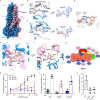Structural insights into the mechanism of pancreatic KATP channel regulation by nucleotides
- PMID: 35589716
- PMCID: PMC9120461
- DOI: 10.1038/s41467-022-30430-4
Structural insights into the mechanism of pancreatic KATP channel regulation by nucleotides
Abstract
ATP-sensitive potassium channels (KATP) are metabolic sensors that convert the intracellular ATP/ADP ratio to the excitability of cells. They are involved in many physiological processes and implicated in several human diseases. Here we present the cryo-EM structures of the pancreatic KATP channel in both the closed state and the pre-open state, resolved in the same sample. We observe the binding of nucleotides at the inhibitory sites of the Kir6.2 channel in the closed but not in the pre-open state. Structural comparisons reveal the mechanism for ATP inhibition and Mg-ADP activation, two fundamental properties of KATP channels. Moreover, the structures also uncover the activation mechanism of diazoxide-type KATP openers.
© 2022. The Author(s).
Conflict of interest statement
The authors declare no competing interests.
Figures






Similar articles
-
The inhibition mechanism of the SUR2A-containing KATP channel by a regulatory helix.Nat Commun. 2023 Jun 17;14(1):3608. doi: 10.1038/s41467-023-39379-4. Nat Commun. 2023. PMID: 37330603 Free PMC article.
-
Role of the C-terminus of SUR in the differential regulation of β-cell and cardiac KATP channels by MgADP and metabolism.J Physiol. 2018 Dec;596(24):6205-6217. doi: 10.1113/JP276708. Epub 2018 Oct 14. J Physiol. 2018. PMID: 30179258 Free PMC article.
-
Vascular KATP channel structural dynamics reveal regulatory mechanism by Mg-nucleotides.Proc Natl Acad Sci U S A. 2021 Nov 2;118(44):e2109441118. doi: 10.1073/pnas.2109441118. Proc Natl Acad Sci U S A. 2021. PMID: 34711681 Free PMC article.
-
Cryo-electron microscopy structures and progress toward a dynamic understanding of KATP channels.J Gen Physiol. 2018 May 7;150(5):653-669. doi: 10.1085/jgp.201711978. Epub 2018 Apr 23. J Gen Physiol. 2018. PMID: 29685928 Free PMC article. Review.
-
Mechanistic insights on KATP channel regulation from cryo-EM structures.J Gen Physiol. 2023 Jan 2;155(1):e202113046. doi: 10.1085/jgp.202113046. Epub 2022 Nov 28. J Gen Physiol. 2023. PMID: 36441147 Free PMC article. Review.
Cited by
-
KATP channel mutations in congenital hyperinsulinism: Progress and challenges towards mechanism-based therapies.Front Endocrinol (Lausanne). 2023 Mar 28;14:1161117. doi: 10.3389/fendo.2023.1161117. eCollection 2023. Front Endocrinol (Lausanne). 2023. PMID: 37056678 Free PMC article. Review.
-
Non-radioactive Rb+ Efflux Assay for Screening KATP Channel Modulators.Methods Mol Biol. 2024;2796:191-210. doi: 10.1007/978-1-0716-3818-7_12. Methods Mol Biol. 2024. PMID: 38856903
-
Personalized Therapeutics for KATP-Dependent Pathologies.Annu Rev Pharmacol Toxicol. 2023 Jan 20;63:541-563. doi: 10.1146/annurev-pharmtox-051921-123023. Epub 2022 Sep 28. Annu Rev Pharmacol Toxicol. 2023. PMID: 36170658 Free PMC article. Review.
-
Mitochondrial Ca2+-coupled generation of reactive oxygen species, peroxynitrite formation, and endothelial dysfunction in Cantú syndrome.JCI Insight. 2024 Aug 1;9(17):e176212. doi: 10.1172/jci.insight.176212. JCI Insight. 2024. PMID: 39088268 Free PMC article.
-
Structure of an open KATP channel reveals tandem PIP2 binding sites mediating the Kir6.2 and SUR1 regulatory interface.Nat Commun. 2024 Mar 20;15(1):2502. doi: 10.1038/s41467-024-46751-5. Nat Commun. 2024. PMID: 38509107 Free PMC article.
References
Publication types
MeSH terms
Substances
LinkOut - more resources
Full Text Sources

